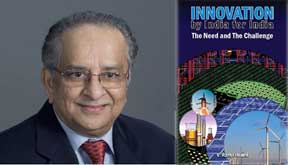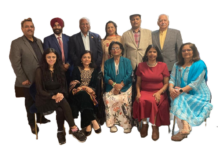
NEW YORK: The number of Indians and persons of Indian origin who have enriched many nations, and humanity as a whole, through applied research and innovation in a multitude of fields has increased dramatically, says V. Ramaswami, the New Jersey based author of the to-be released book “Innovation by India for India: the need & the challenge.”
This should be re-assuring for India particularly because a significant fraction of these have had their initial graduate education and training in India. There can be no doubt that the capacity of the Indian mind and the will of the Indian can match any other. India’s indigenous scientific advances in the nuclear, space, and super-computer technologies are remarkable and attest further to the scientific and engineering talent in the country, he says.
India’s scientific and technical establishments have many feats to boast about, including the recent successful launch of an orbiter to Mars at a per kilometer cost “less than that of a one kilometer auto-rickshaw ride in Ahmedabad.” Despite all of its above accomplishments, India is yet to harness commercially its research and innovation capabilities. Despite being a significant contributor to the information sector, not a single Indian enterprise has come close to any of the new age technology giants.
What are the impediments that hold back the Indian in India in the sphere of applied research and its commercialization? Why it is that new product generation is low even at the low end where little technology is needed? Can those issues be redressed and if so how? These concerns form the main focus of this book. Some key factors are identified and examined in detail in the Indian context to find some possible actions for improvement in the book.
The book deals with the creation of ecology for commercializable innovations by Indians in India and owned by India. The timing of the book is perfect. There is so much interest in the Modi government to generate many start-ups but unfortunately, it has not worked out well from the response to the call for applications for funding, the author says.
The most poignant example is the fact that our soldiers in Kargil were struggling with hand cranked telephones while Pakistanis had Motorola satellite phones for which Indian engineers wrote the software. Whoever got rich by working for others? “Make in India” is much needed but if we stop there, we will become a nation of coolies and laborers for others and not realize our “tryst with destiny” much talked about, he says.
He was motivated to write the book by former Indian President Dr. APJ Abdul Kalam whom he had met in Anna University in Chennai where he had gone to deliver the Ramanujan lecture series. “In a 45 minute one on one session, I gave him a lot of my views and he felt I should put them down in writing.
He said he is betting entirely on India’s young.” The book comes recommended by Dr. Anurag Kumar, Director of the Indian Institute of Science and Padmabhushan Dr. Rajaraman of IISC’s supercomputer center.”
The author, Dr. Vaidyanathan Ramaswami, a former Chief Scientist at Bell Communications Research, has an innovative track record of research in applied probability and telecommunications with work impacting many real world systems and international standards. He is the author of over seventy five research papers and a noted monograph, and holds many patents related to communications.
His career has also covered academia as a faculty member and is embellished further by his involvement with several start ups in the areas of strategy and research. He has a deep interest in India and has written many articles and blogs on Carnatic music, Hindu philosophy, and Indian economy and politics.
The book is to be released in Chennai on July 22 at the Alumni Association meeting of the Madras Institute of Technology which is the alma mater of Dr. Abdul Kalam.
PM Swamy






